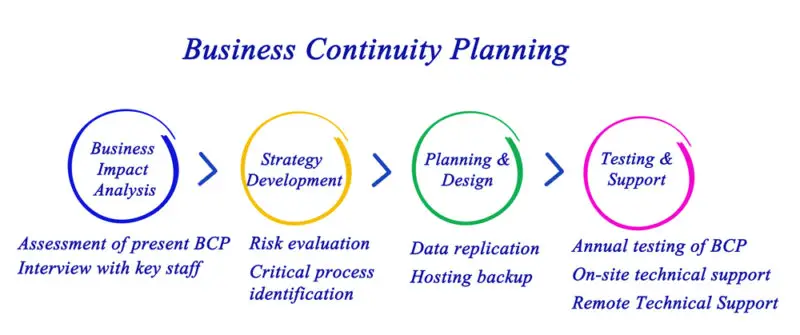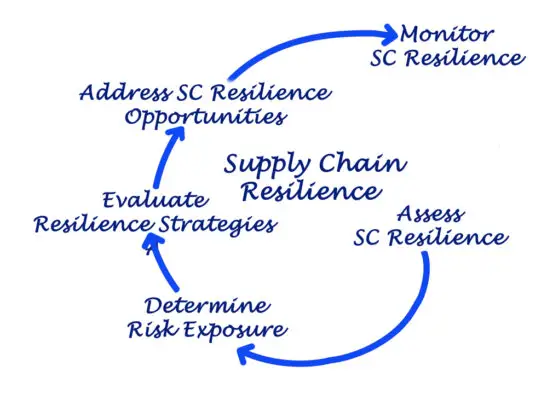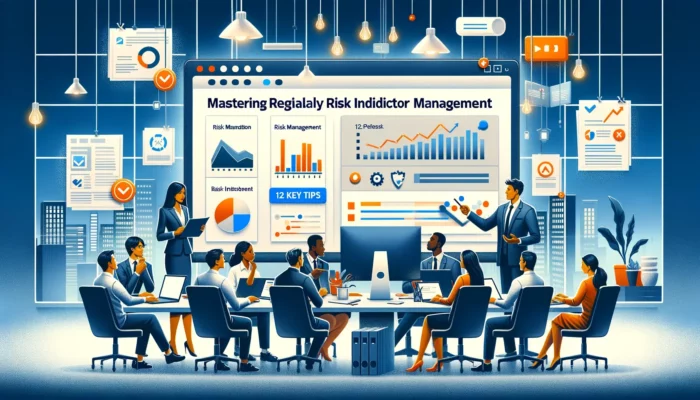A Business Continuity Plan (BCP) for the manufacturing industry is a strategic framework designed to prepare a company for potential disruptions to its operations.
The goal is to ensure that critical business functions can continue during and after a disaster, whether it’s a natural disaster, technological failure, supply chain issues, or another type of unforeseen event.
Here’s a comprehensive guide to creating a BCP for the manufacturing industry:
- Risk Assessment: Identify potential risks that could impact your manufacturing operations. This includes analyzing the likelihood and impact of various threats.
- Business Impact Analysis (BIA): Conduct a BIA to determine how different disruptions could affect your business and identify which functions are critical to your operation’s survival. This will help prioritize recovery efforts.
- Recovery Strategies: Develop strategies to recover critical business functions. This might involve alternative production methods, backup suppliers, or relocating to an alternate site.
- Plan Development: Document the BCP, outlining roles, responsibilities, and procedures for maintaining operations. This should include emergency response actions as well as longer-term recovery steps.
- Communication Plan: Establish a communication plan to keep employees, suppliers, and customers informed during a disruption. Clear lines of communication are essential for effective response and recovery.
- Training and Testing: Train your staff on the BCP and conduct regular drills to test the plan. This ensures everyone knows what to do and can help identify any weaknesses in the plan.
- Maintenance and Review: Regularly review and update the BCP to reflect changes in your business operations, new potential risks, and lessons learned from tests and actual events.
A smart business continuity plan doesn’t only look toward the future. It involves looking at what you can do here and now to ensure your company is prepared for any disruption (Agility Recovery).
Implementing a structured and repeatable process, applied to one business unit at a time, can keep business continuity planning efforts manageable and more effective (Infotech).
A comprehensive BCP for the manufacturing industry takes into account all aspects of the business and creates a system designed to prevent and recover from potential threats, ensuring that personnel and assets are protected and that the company can continue to operate effectively ([SweetProcess](https
Business continuity planning is a critical part of any organization’s risk management strategy. This is especially true in the manufacturing industry, where a disruption in operations can lead to significant financial losses and damage to the company’s reputation.
A business continuity plan (BCP) is a comprehensive document that outlines how a company will continue to operate in the event of an unplanned disruption in service.
Understanding business continuity is key to developing an effective BCP for the manufacturing industry. This involves identifying and analyzing potential risks to the organization, such as natural disasters, cyber-attacks, and supply chain disruptions.

Once these risks have been identified, a business continuity strategy can be developed to minimize the impact of these disruptions on the organization. This strategy may include backup power generation, redundant supply chains, and remote work capabilities.
Key Takeaways
- Business continuity planning is critical for the manufacturing industry to minimize the impact of disruptions on the organization.
- Understanding potential risks is key to developing an effective business continuity strategy.
- An effective BCP should include backup power generation, redundant supply chains, and remote work capabilities.
Understanding Business Continuity
Key Concepts
Business continuity refers to the ability of an organization to continue its operations, even in the face of unforeseen events or disasters.
It involves the development of a plan that outlines how the organization will respond to and recover from disruptions. A business continuity plan aims to minimize the impact of a disruption on the organization’s operations, customers, and stakeholders.
A business continuity plan typically includes procedures for identifying potential disruptions, assessing their impact, and implementing measures to mitigate their effects. It also outlines how the organization will communicate with employees, customers, and other stakeholders during a disruption.
Importance in Manufacturing
Business continuity planning is particularly important in the manufacturing industry, where disruptions can have significant consequences.
Manufacturing operations often involve multiple suppliers, processes, and systems. A disruption in any one of these areas can cause delays, production shutdowns, and supply chain disruptions.
In the manufacturing industry, a business continuity plan can help ensure critical operations continue, even in the face of disruptions such as natural disasters, equipment failures, or cyberattacks.
It can also help minimize the impact of disruptions on customers and suppliers, ensuring that the organization can continue to meet its obligations.
To develop an effective business continuity plan for the manufacturing industry, it is important to identify the critical processes and systems that are essential to the organization’s operations.
This may involve conducting a risk assessment, evaluating the impact of potential disruptions, and developing strategies to mitigate those risks. The plan should also include procedures for testing and updating the plan on a regular basis to ensure that it remains effective in the face of changing circumstances.
Risk Assessment and Analysis
Manufacturing companies face various risks that can disrupt their operations and lead to significant losses. A business continuity plan (BCP) is a crucial tool that helps organizations identify potential threats and develop strategies to mitigate them. The risk assessment and analysis phase is the first step in creating a BCP.
Identifying Potential Threats
The first step in risk assessment is to identify potential threats. These threats can be natural disasters, such as earthquakes, floods, and hurricanes, or man-made events, such as cyber-attacks, power outages, and supply chain disruptions.
It is essential to consider all possible threats and their likelihood of occurrence. A comprehensive list of potential threats can be created using a brainstorming session with key stakeholders, reviewing historical data, and conducting a risk assessment audit.
Evaluating Business Impact
Once potential threats are identified, the next step is to evaluate their potential impact on the business. This involves assessing the criticality of each business function and determining the financial and reputational impact of a disruption.
The impact assessment should include the estimated time to recover, the cost of recovery, and the potential loss of revenue. This information can be used to prioritize the recovery of critical business functions and develop recovery time objectives (RTOs) and recovery point objectives (RPOs).
Risk Mitigation Strategies
After identifying potential threats and evaluating their impact, the next step is to develop risk mitigation strategies. These strategies can include risk avoidance, reduction, sharing, or acceptance.
Risk avoidance involves eliminating the risk, such as relocating the business to a safer location. Risk reduction involves implementing measures to minimize the likelihood or impact of a risk, such as installing backup power generators or fire suppression systems.
Risk sharing involves transferring the risk to a third party, such as by purchasing insurance. Risk acceptance involves accepting and developing a plan to manage risk, such as creating backup plans or redundancies.
In conclusion, the risk assessment and analysis phase is critical in developing a BCP for manufacturing companies. By identifying potential threats, evaluating their impact, and developing risk mitigation strategies, organizations can minimize the impact of disruptions and ensure the continuity of their operations.
Business Continuity Strategy Development
Developing a comprehensive business continuity strategy is crucial for manufacturing companies to minimize disruptions’ impact and ensure operations’ continuity.
The following subsections outline key areas to consider when developing a business continuity plan for the manufacturing industry.
Recovery Objectives
The first step in developing a business continuity plan is establishing recovery objectives. This involves identifying critical processes, systems, and resources required to maintain operations.
Recovery objectives should be aligned with business goals and clearly define the maximum tolerable downtime for each critical process and system.
Resource Management
Resource management is an essential component of a business continuity plan. This involves identifying and allocating resources required for recovery efforts.
A resource inventory that includes information on personnel, equipment, and materials required for recovery efforts should be maintained. Resource management also involves identifying alternate resources that can be used in case of a disruption.
Supply Chain Continuity
Manufacturing companies rely heavily on their supply chain to maintain operations. Disruptions in the supply chain can have a significant impact on production.
Therefore, it is important to identify critical suppliers and establish contingency plans to ensure continuity of supply. This may involve identifying alternate suppliers, establishing safety stock levels, or developing supplier agreements prioritising delivery during a disruption.

Technology and Data
Technology and data are critical components of modern manufacturing operations. Therefore, it is essential to establish plans to ensure the continuity of technology and data systems.
This may involve implementing redundant systems, establishing data backup and recovery procedures, or developing plans to restore critical systems and data in case of a disruption.
In summary, developing a comprehensive business continuity plan is essential for manufacturing companies to minimize disruptions’ impact and ensure operations’ continuity.
Recovery objectives, resource management, supply chain continuity, and technology and data are key when developing a business continuity plan for the manufacturing industry.
Plan Implementation and Training
Once a business continuity plan (BCP) has been developed for a manufacturing company, it is crucial that the plan is implemented and all employees are trained on the procedures outlined in the plan.
This section will cover the two main aspects of plan implementation and training: Employee Training and Plan Activation Procedures.
Employee Training
Employee training is an essential part of BCP implementation. All employees should be trained on the procedures outlined in the plan, including their roles and responsibilities during a disruption. The training should cover the following topics:
- How to recognize a disruption and when to activate the BCP.
- The roles and responsibilities of each employee during a disruption.
- Communication procedures during a disruption.
- Evacuation procedures, if applicable.
- Business recovery procedures.
It is important to conduct regular training sessions to ensure that all employees are aware of the procedures and are prepared to act quickly in the event of a disruption.
Plan Activation Procedures
The plan activation procedures should be clearly outlined in the BCP. The procedures should include the following:
- Who has the authority to activate the plan?
- How the plan will be activated.
- Who will be responsible for communication during a disruption?
- How will employees be notified of the disruption and the plan’s activation?
- How will the plan be monitored and updated during the disruption?
- How will the plan be deactivated once the disruption has been resolved?
It is important to test the plan activation procedures regularly to ensure they are effective and that all employees know their roles and responsibilities. Regular testing also allows for updates and improvements to be made to the plan as needed.
Implementing and training a BCP is crucial for ensuring that a manufacturing company can continue to function and recover quickly during a disruption.
Testing and Maintenance
Testing and maintenance are essential components of any business continuity plan. Regular testing schedules ensure the plan is up-to-date and all stakeholders know their roles and responsibilities.
Plan updates and revisions are necessary to ensure that the plan reflects the current state of the organization and the industry.
Regular Testing Schedules
Regular testing schedules are critical to ensure the business continuity plan is effective. Organizations should conduct tests at least once a year and more frequently if significant changes exist to the organization or the industry.
Tabletop exercises are a common form of testing, where stakeholders gather to discuss hypothetical scenarios and how they would respond. These exercises help identify gaps in the plan and ensure all stakeholders know their roles and responsibilities.
Another form of testing is a simulation exercise, which involves a more comprehensive test of the plan. This exercise involves simulating an actual event and testing the organisation’s response.
Plan Updates and Revisions
Plan updates and revisions are necessary to ensure that the plan reflects the current state of the organization and the industry. Organizations should review their business continuity plan at least once a year and update it as necessary.
Updates may be necessary due to changes in the organization, such as new products or services, changes in the workforce, or changes in the organizational structure. Organizations should also consider changes in the industry, such as new regulations or emerging threats.
Revisions may be necessary due to feedback from testing or actual events. Organizations should review their response to events and identify areas for improvement. These improvements should be incorporated into the plan to ensure the organization is better prepared for future events.
In conclusion, regular testing schedules, plan updates, and revisions are essential to any business continuity plan. These activities ensure that the plan is effective and reflects the current state of the organization and the industry.
Crisis Communication
In the event of a crisis, communication is key. Effective communication can help minimize damage and prevent further disruption to the manufacturing process. The following are some important considerations for crisis communication in the manufacturing industry.
Internal Communication Protocols
A clear and well-defined internal communication protocol is essential for managing a crisis. This includes identifying key stakeholders and ensuring that they are informed in a timely manner.
It is also important to establish clear communication lines and ensure that everyone knows their role in the crisis response plan.
Establishing a communication tree is one effective way to ensure that everyone is informed. This involves identifying a primary point of contact responsible for communicating with the rest of the team.
The primary point of contact then communicates with a designated secondary point of contact, who communicates with the rest of the team. This ensures that everyone is informed in a timely and efficient manner.
External Communication Plans
In addition to internal communication protocols, it is also important to have a well-defined external communication plan.
This involves identifying key stakeholders outside of the organization, such as customers, suppliers, and regulatory agencies, and ensuring that they are informed promptly and accurately.
Establishing a crisis communication team is an effective way to communicate with external stakeholders. This team should be responsible for communicating with external stakeholders and should include representatives from key departments such as public relations, legal, and operations.
It is also important to have a clear and concise message that can be communicated to external stakeholders. This message should include information such as the nature of the crisis, the steps being taken to address the crisis, and any potential impact on stakeholders.
By having a clear and concise message, the organization can help prevent rumours and misinformation from spreading.
Regulatory Compliance and Standards
In the manufacturing industry, regulatory compliance is critical for ensuring the safety and quality of products, protecting the environment, and maintaining ethical business practices. A business continuity plan (BCP) must comply with relevant laws, regulations, and industry standards to be effective and legally defensible.
ISO 22301 is an international standard for business continuity management systems that provides a framework for developing, implementing, and maintaining a BCP.
It specifies requirements for risk assessment, business impact analysis, strategy development, plan implementation, and performance evaluation. By following ISO 22301, manufacturers can ensure that their BCP is aligned with best practices and recognized by stakeholders.
In the United States, the Occupational Safety and Health Administration (OSHA) regulates workplace safety and health through standards, inspections, and enforcement.
Manufacturers must comply with OSHA regulations to protect workers from hazards such as chemical exposure, electrical shock, and machinery accidents. A BCP should include procedures for responding to OSHA inspections, reporting incidents, and addressing noncompliance issues.
The U.S. Food and Drug Administration (FDA) regulates food, drugs, medical devices, and cosmetics safety and quality. Manufacturers must comply with FDA regulations to ensure their products are safe and effective for consumers.
A BCP should include procedures for responding to FDA inspections, recalling products, and addressing quality control issues.
Other regulatory bodies that manufacturers may need to comply with include the Environmental Protection Agency (EPA), the Consumer Product Safety Commission (CPSC), and the National Institute for Occupational Safety and Health (NIOSH).
By incorporating regulatory compliance into their BCP, manufacturers can minimize the risk of legal and financial penalties, protect their reputations, and maintain the trust of their customers.

Review and Continuous Improvement
Creating a Business Continuity Plan (BCP) is not a one-time task but an ongoing process. The manufacturing industry is constantly evolving, and new risks may emerge at any time. Therefore, reviewing and updating the BCP regularly is essential to ensure it remains relevant and effective.
One way to review the BCP is to conduct regular tests and drills. These tests will help identify any weaknesses in the plan, and the results can be used to improve the plan.
It is recommended that tests are conducted at least once a year, and the results are documented for future reference.
Another way to review the BCP is to analyze past incidents and how they were handled. This analysis will help identify any gaps in the plan and how they can be addressed. Documenting the analysis and using it to improve the plan is essential.
Continuous improvement is a critical aspect of the BCP. The manufacturing industry is constantly changing, and new risks may emerge.
Therefore, it is essential to improve the plan to ensure it remains effective continuously. This can be achieved by conducting regular reviews, analyzing past incidents, and incorporating new risks into the plan.
To ensure continuous improvement, it is essential to assign someone to be responsible for the BCP. This person should have the authority to make changes to the plan and be responsible for ensuring that the plan is reviewed and updated regularly.
Creating a BCP is not a one-time task but an ongoing process. Regular reviews, tests, and drills are essential to ensure the plan remains relevant and effective.
Continuous improvement is critical to ensure the plan can address new emerging risks. By assigning someone to be responsible for the plan, the manufacturing industry can ensure that the BCP is continuously reviewed and updated to remain effective.

Chris Ekai is a Risk Management expert with over 10 years of experience in the field. He has a Master’s(MSc) degree in Risk Management from University of Portsmouth and is a CPA and Finance professional. He currently works as a Content Manager at Risk Publishing, writing about Enterprise Risk Management, Business Continuity Management and Project Management.

